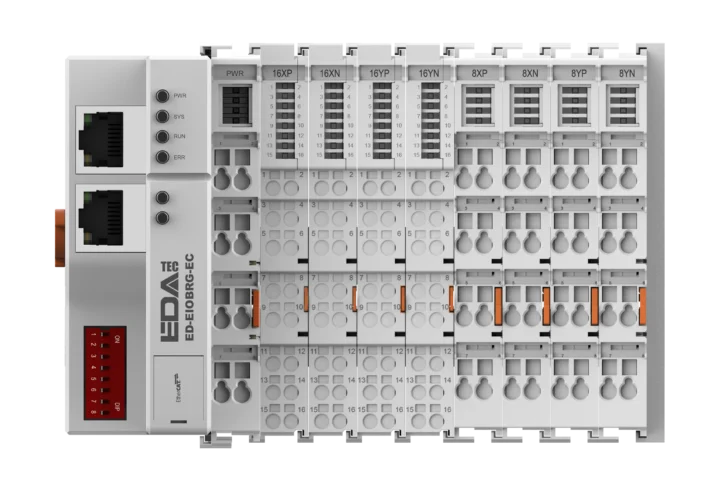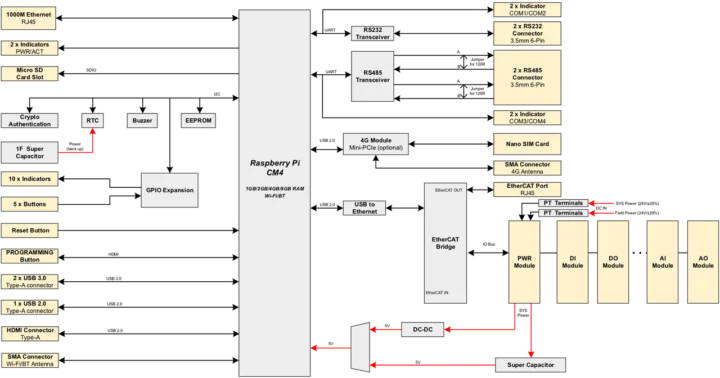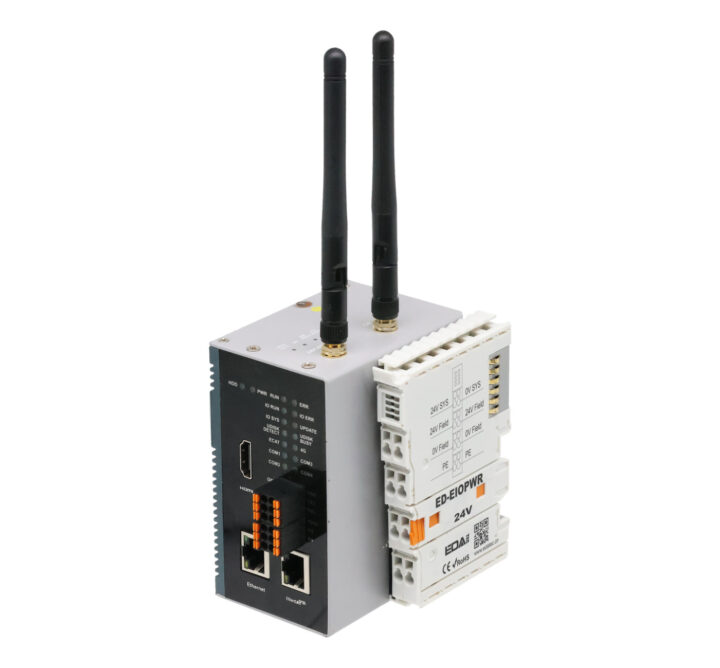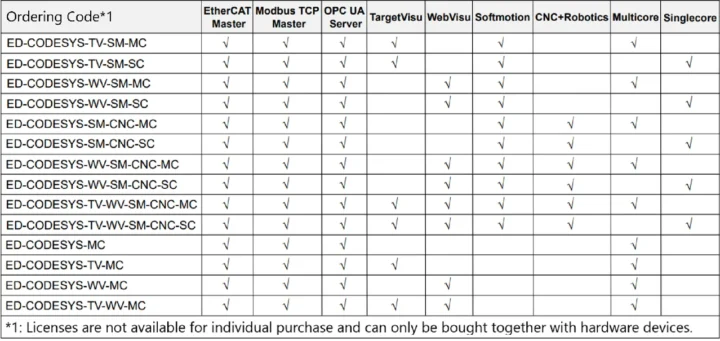EDATEC ED-PLC2010 is an industrial controller powered by a Raspberry Pi CM4, supporting EtherCAT and Modbus interfaces, up to 32 I/O modules, and preloaded with CODESYS runtime for real-time core and visualization capabilities.
DIN Rain-mountable Raspberry Pi CM4 industrial controllers are not exactly new, with products such as Modberry 500 CM4 and Edgebox-RPI4 announced shortly after the launch of the Raspberry Pi Compute Module 4 in 2020. More recently (2024), Seeed Studio introduced the reComputer R1113-10 IoT gateway, and Sfera Labs launched the Strato Pi Max. TECHBASE also upgraded the Modberry 500 with a more powerful CM5 module. EDATEC ED-PL2010 mostly differentiates itself by shipping with a licensed version of CODESYS runtime for industrial automation. It’s also possible with other vendors, but the license might need to be purchased separatly.
EDATEC ED-PLC2010 specifications:
- SoM – Raspberry Pi CM4
- SoC – Broadcom BCM2711
- CPU – Quad-core Cortex-A72 SoC @ 1.5GHz
- GPU – VideoCore VI with support for OpenGL ES 3.1 and Vulkan 1.0
- VPU
- Decode – H.265/HEVC up to 4Kp60, H.264 up to 1080p60
- Encode – H.264 up to 1080p30
- Memory – 1GB, 2GB, 4GB, or 8GB LPDDR4-3200
- Storage – 8GB, 16GB, or 32GB eMMC flash
- Optional Wireless module with WiFi 5 and Bluetooth 5.0
- SoC – Broadcom BCM2711
- Storage
- MicroSD card slot for user data
- 4KB EEPROM
- Video Output – HDMI 2.0 port up to 4Kp60
- Networking
- Gigabit Ethernet RJ45 port
- EtherCAT RJ45 port
- Up to 8x axes support
- 1x EtherCAT master, up to 128x EtherCAT slaves
- 1x Modbus TCP master, up to 63x Modbus TCP slaves
- Optional WiFi/Bluetooth (on CM4)
- Optional 4G LTE cellular mini PCIe module (EC20 or EC25 with region-specific variants)
- 2x SMA connectors for WiFi/Bluetooth and 4G antenna
- USB
- 2x USB 3.0 Type-A (5 Gbps) ports
- 1x USB 2.0 Type-A port
- Serial
- 2x RS485 via 6-pin terminal block with isolation
- 2x RS232 via 6-pin terminal block with isolation
- Expansion I/Os – Up to 32 “ED-EIO” I/O modules with type DI, DO, AI, AO, RTD, TC, and High-Speed Counter
- Security – Crypto authentication chip
- Misc
- 16x LED indicators for power, Ethercat, 4G, serial ports, system status, etc…
- Buttons for Reset, Factory Reset, IP address Reset, UDISK RM (remove USB drive safely), IMP (import PLC), STOP/START (for runtime)
- RTC with 1F SuperCAP backup (option for CR1220 battery)
- Buzzer
- Power supply
- System Power – 24V DC-in via 2-pin terminal block
- Field Power – 24V DC-in via 2-pin terminal block
- Power Consumption – Up to 24 Watts
- Dimensions – 103 x 71 x 81mm excluding antenna and DIN Rail bracket
- Weight – About 750 grams
- Temperature Range – Operating: -10 to 55°C; storage: -20 to 60°C
- Humidity – 5 to 95% RH

The company offers a long list of ED-EIO module, including digital input and output modules with 8 to 16 channels, analog input modules with 4 or 8 channels, 4-channel analog output modules, and specialized modules with EtherCAT coupler, RTD input, thermocouple input, high-speed counter, power expansion, or EtherCAT terminal cover. You’ll find the full list on the remote I/O modules page of the company’s website.
The Raspberry Pi CM4-powered industrial controller runs Raspberry Pi OS (Lite) 64-bit and is pre-loaded with a licensed version of the CODESYS Runtime with the following features:
- Multicore CODESYS Control Runtime System, with the Singlecore CODESYS Control Runtime System available as an optional add-on
- Programming Mode – IEC 61131-3 programming languages, including ST, LD, FBD, SFC, and CFC
- IDE Support – CODESYS V3.5
- Fieldbus – CODESYS EtherCAT Master and CODESYS Modbus TCP Master
- Motion Control – Optional CODESYS SoftMotion and CNC+Robotics
- Visualization – Optional CODESYS TargetVisu and CODESYS WebVisu
- Support OPC UA Server

Different CODESYS licenses are available when purchasing an ED-PLC2010 controller, depending on the features needed.
Some EDATEC ED-PLC2010 variants and ED-EIO module are listed on DigiKey, but all are currently out of stock. Check out the product page for more information and documentation such as a datasheet and a user manual to get started.


Jean-Luc started CNX Software in 2010 as a part-time endeavor, before quitting his job as a software engineering manager, and starting to write daily news, and reviews full time later in 2011.
Support CNX Software! Donate via cryptocurrencies, become a Patron on Patreon, or purchase goods on Amazon or Aliexpress







Price for the CPU module is about in the range of a wago unit, just expansion is cheaper. However here I always have to buy packs of 5 for each of the modules…
CODESYS is a weird system.. they keep pushing it’s hard real-time and having PLC-like features, on top of a pretty standard Linux dist. Make absolutely no sense.
I customer used it for a prototype they wanted refined and productified, and basically forced use using CODESYS in the end product.. the jitter was enormous and I hated almost everything about the end result, but they liked it and we got paid..
Never again. Embedded cpp on an arm m4 with canopen would have been so much easier, faster, cheaper and safer..
Can’t for the life of me understand how they manage to get the SoftPLC certified for safety-critical applications
Thanks.